Birds That Are a Sort of Blackinsh Blue
The animal kingdom gives us rainbows of color with butterflies and chameleons and clownfish, but birds give us just as much of a show. Between the peacock, the toucan, and the macaw, there's a kaleidoscope of color in the avian family. So have you ever wondered about the types of birds that are blue?
Are there more than just the bluebird? There sure are so let's talk about them in all their brilliance, and find out which blue bird played a critical role in saving the oak tree!
1. The Eastern Bluebird
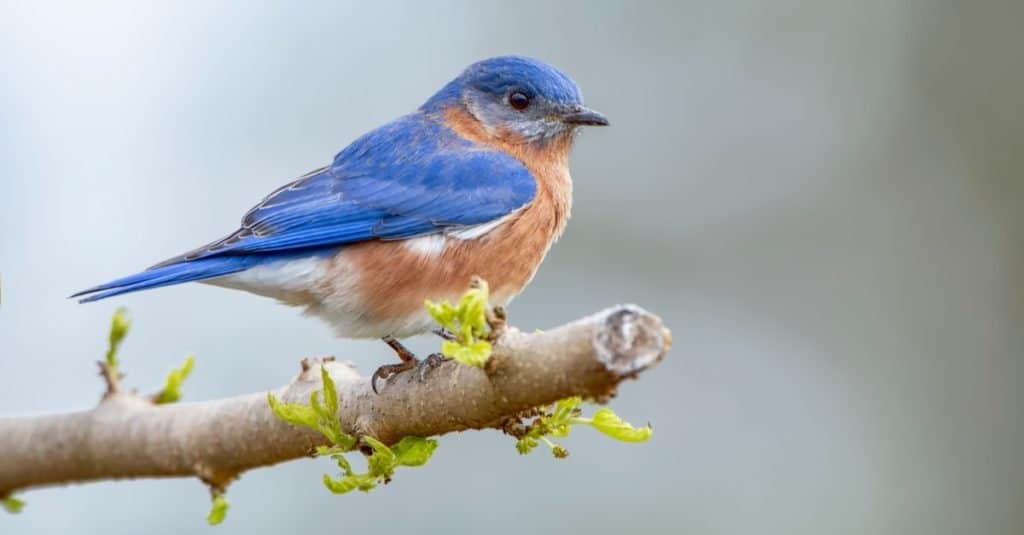
Bonnie Taylor Barry/Shutterstock.com
If this is the bird that popped in your head first when you thought about a blue bird, you'd be among the many who might think this is the only blue in the azure sky.
The eastern bluebird is the most prevalent species of the three bluebirds: The eastern bluebirds, western bluebirds, and mountain bluebirds and can be seen throughout eastern North America.
Bluebirds are in the thrush family, who have a melodic tone when they sing, so they come by their vocal talents quite honestly.
- Color: The male is mostly blue while the females are a dull, bluish-gray with varying hues of blue on the wings and tail.
- Diet: Insects captured on the ground are the bluebird's preferred cuisine for much of the year. Caterpillars, crickets, grasshoppers, beetles, spiders and mealworms are favorites on the menu.
Although this popular bird's perching preference is on low tree branches for quick access to insects, grubs, or other tiny prey, they can spot their bug-meals from 60 ft. or more away!
Bluebirds can be found along field edges, golf courses, parks, backyards, sparse woods, and other open areas.
The perfect turquoise hue of their eggs is exceptionally beautiful with their color resembling the crystal-clear waters of the Caribbean.
Their migration to the north or south is a family affair and they band together in large mixed flocks for protection and to find food.
In the Fall, they eat large amounts of fruit including mistletoe, blueberries, hackberries, honeysuckle, and more.
Eastern bluebird nesting habits

Steve Byland/Shutterstock.com
The male begins bringing materials into a nesting area and fluttering his wings to attract the attention of a female (not too far off from human behavior), and when the female arrives, she builds the nest.
They're built fairly low from 2-20 ft. off the ground, rarely higher, and are located in cavities like man made bird structures/nest boxes and also old woodpecker holes in dead pine or oak trees.
The thing about woodpecker holes is there are more than just bluebirds trying to find one to live in. There are other birds and small animals who nest in natural cavities as well. So when other bird species like house sparrows and European starlings come wandering into the area/territory to stake a claim, the male bluebird has a problem with that.
So much so that he'll attack other males who get too close and think they've found a new pad.
Fun fact: Males will chase each other at high speed, fight with their feet, pull at feathers with their beaks, and hit each other with their wings when fighting over territory. They don't mess around when it comes to protecting their families.
(Okay, I don't know how fun that fact was, but it was educational.)
2. Indigo Bunting
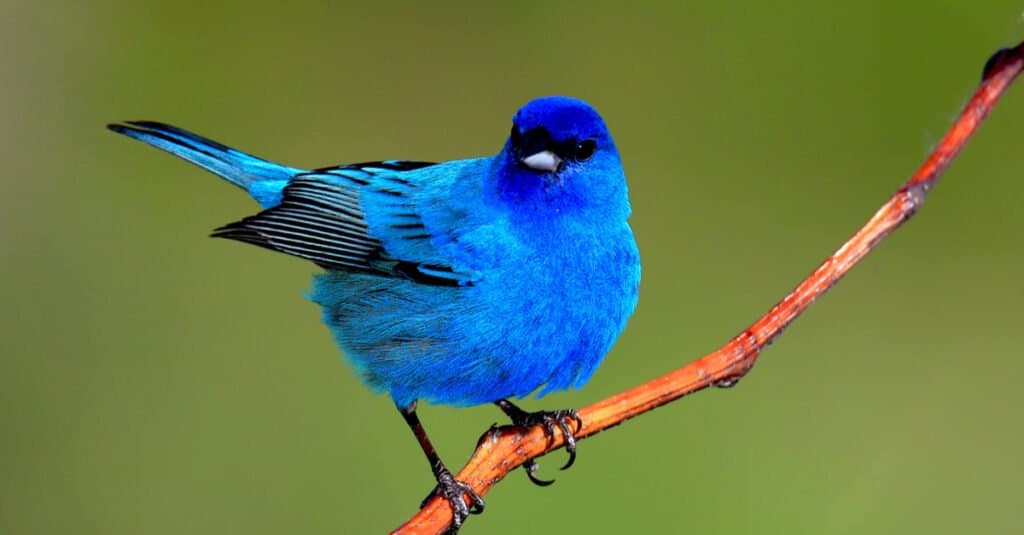
John L. Absher/Shutterstock.com
This guy is blue! Ironically, the indigo bunting, in all its blue glory, is in the cardinal family.
This species often migrates by night using the stars to navigate. Guess you could call him a night owl. Singing from high in the treetops or along telephone lines, you won't believe where they build their nests but keep reading to find out.
- Color: The males are a deep vibrant blue all over in the Summer and have a shiny silver-gray bill. It almost looks fake. Their color changes to brown during the Winter. The females are brown year-round
- Diet: The indigo bunting eats insects and spiders during the summer months and seeds and berries during the Winter — Grass seeds are a favorite meal. They forage for food on the ground or in trees or shrubs.
The indigo bunting's favorite place to be is in brushy areas like grasslands, shrubs, brushy forest edges, and hedgerows.
The female of the species is less often seen since she's usually busy. She's responsible for the eggs and their young who are hidden in dense thickets.
Indigo bunting nesting habits

Liz Weber/Shutterstock.com
The job of nest-building is handled solely by the female. Home is generally a concealed area, a dense shrub or low tree, that is 1-3 ft. above ground. Yes, they're that low. Where they live and where they roost couldn't be more different.
Indigo bunting nests are made from grass, weeds, and easily constructible materials, bound with spider web, and are built in the shape of a small cup. Their young usually leave the nest 9-12 days after hatching.
Fun fact: The male defends its territory with singing/chirping.
3. Blue Grosbeak
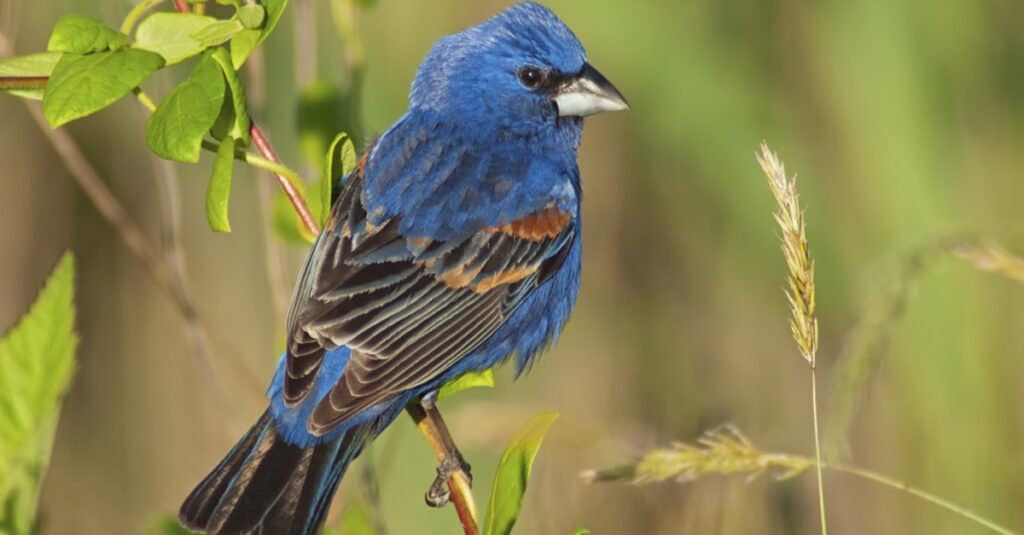
Michael G. Mill/Shutterstock.com
Blue grosbeaks love being in thickets and overgrown fields where they're often hidden. They're named after their two most striking characteristics – their large bills and color – and they prefer to be close to water.
- Color: The males have a mostly bright-blue body while the females are a light brown.
- Diet: Their diet consists mostly of insects and seeds. They eat lots of bugs during the Summer including grasshoppers, beetles, caterpillars, cicadas, praying mantises, and others. They'll also dine on spiders and snails.
Nesting habits
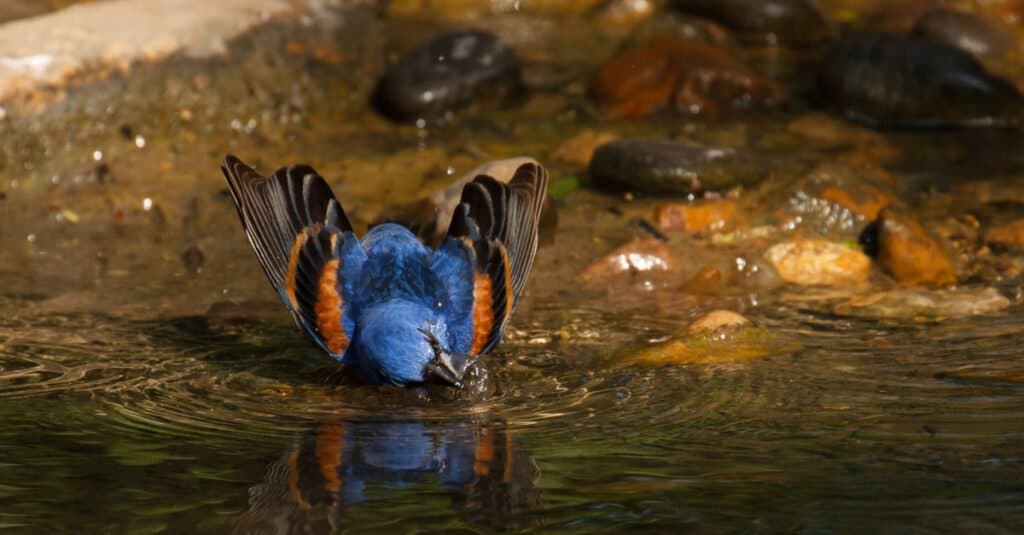
Kenny Salazar/Shutterstock.com
This bird is another low-dwelling lover with their nests being built by the female from 3-10 ft. off the ground. Largely made from twigs, weeds, animal hair, strips of bark, leaves, and other natural environmental surroundings, their nests are also known to include foreign objects like pieces of paper or rags.
Males might be found feeding the nestlings — playing Mr. Mom — when the female is preparing a second nest.
Fun fact: The blue grosbeak often takes short flights to grab insects in mid-air.
4. Blue Jay
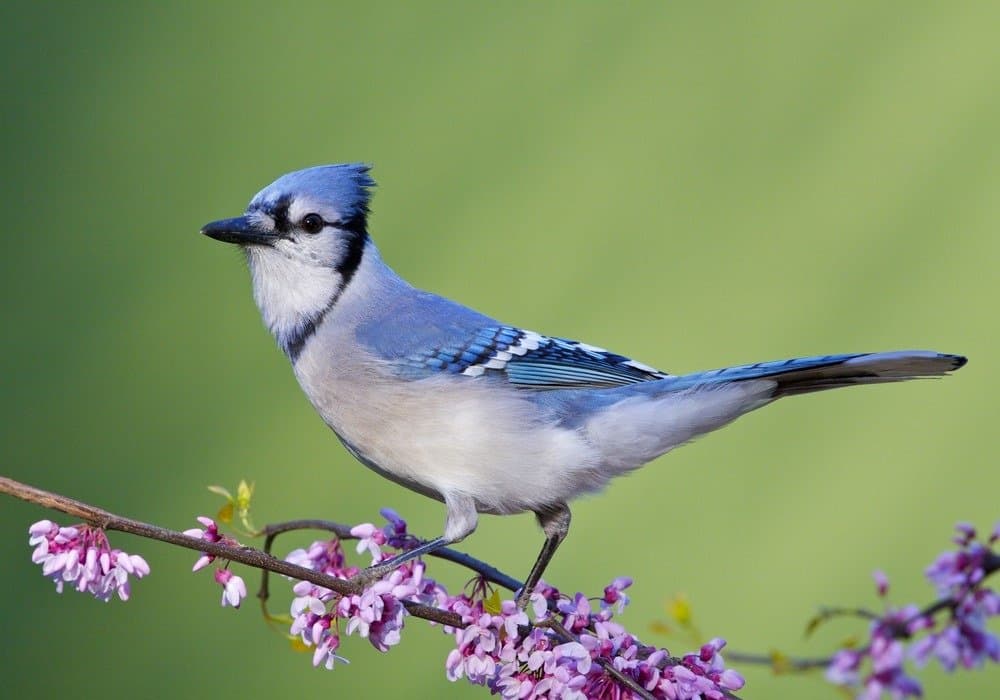
Tom Reichner/Shutterstock.com
There are four recognized subspecies of the blue jay. (Also known as the jay bird) People might think the bluebird and the blue jay are the same bird, but they're not. They are two different animals (quite literally) and frankly, not even remotely the same.
They belong to different families, they're vocally different, and maybe the most stark difference is the way they look. Also, blue jays live in forests in the forks of trees where branches meet the trunk up to 20 feet high, but the bluebird lives in low-lying places. (See #1 above for more info on the bluebird.)
- Color: The male is highly recognizable with blue, black, and white colors. The females are usually gray with light orange on their chests. (Are you seeing the trend between the females having the more muted colors with the males having the bolder ones? But that's another article.) If you see a bird with a pitch black head and blue body, it is likely a Stellar's jay.
A stellar's jay is not a blue jay. They're related but have definite differences such as:
A. The stellar's jay bill is long and powerful with a slight hook.
B. Their crests are triangular-shaped.
C. They're found in evergreen forests in western North America.

dimostudio/Shutterstock.com
The main thing blue jays and Stellar's jay have in common is their behavior: Both species are loud, boisterous, and can safely be labeled as "cocky."
Bold jays will often join forces to attack predators in a behavior known as mobbing!Blue jays are not, however, bullet-proof. They're not the fastest-flying bird so predators like hawks and owls watch for them in open areas.
- Diet: Blue jays are omnivorous, with 2/3 of their diet vegetation and 1/3 carnivorous. In the Summer, they and their hatchlings/nestlings eat mostly insects. In the Winter, they eat fruits, nuts, seeds, and acorns. Nuts are one of their favorite foods and they sometimes stash them away or bury them to come back to later. They store other food as well.
"Since jays don't retrieve all the nuts they bury, they aid in the spread of oak and beech trees. In fact, blue jays have been credited with accelerating oak expansion northwards after the last glaciation."
– Northern Woodlands
Blue jays are close cousins of the crows, ravens, and magpies.
When a jay is excited or being aggressive, the crest on the top of his head pops up displaying his "I'm serious" look.
Known to be vocal and aggressive, it's not that uncommon for humans to get dive-bombed by a territorial jay bird. They are also highly intelligent. Fledglings that are captive have even been observed trying to open the door of their cage.
Captive lab species have also been seen fashioning tools from their cage's newspaper to use as rakes. With these, they grabbed food pellets that were just outside their cage.
These smarty-pants-of-flight will also imitate hawk calls to scare off other birds!
Blue jays are complex social creatures, too. They travel in pairs or family groups, rarely flying off on their own.
Like many bird species, blue jays change their behavior from Summer to Winter. In the Summer, breeding birds live in pairs while in the Winter they gather in groups.
A winter flock of blue jays usually has a dominance hierarchy or "pecking order." This determines who eats first and once the social rank is created, there is less conflict/fighting.
Blue jay nesting habits
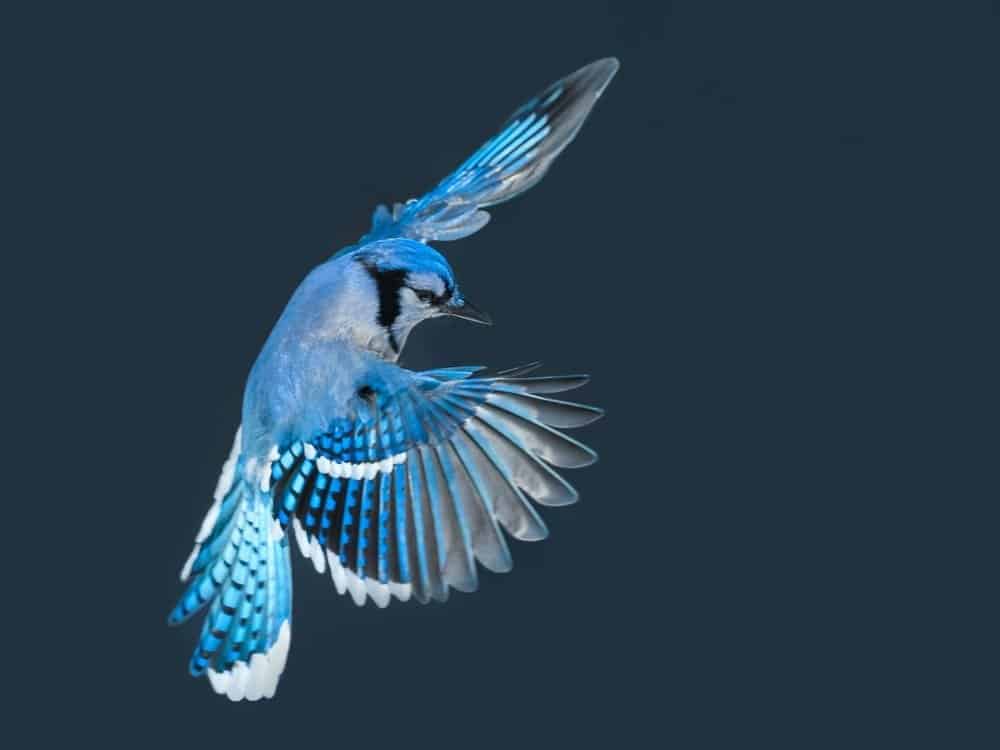
FotoRequest/Shutterstock.com
Both male and female jays build the nest. Teamwork!
They build 10-30 ft. from the ground. It's shaped like a bulky open cup and is made of twigs, grass, weeds, bark strips, moss, and is sometimes held together with mud.
Fun Fact: Blue jays love to eat peanuts in the shell. (I knew the infamous blue jay was one special bird when I realized I couldn't find a stopping point as I was writing about them. More juicy tidbits kept coming up. However, due to my desire to make this a more varied list, and to continue writing for my employer, I moved forward.)
5. Tree Swallow
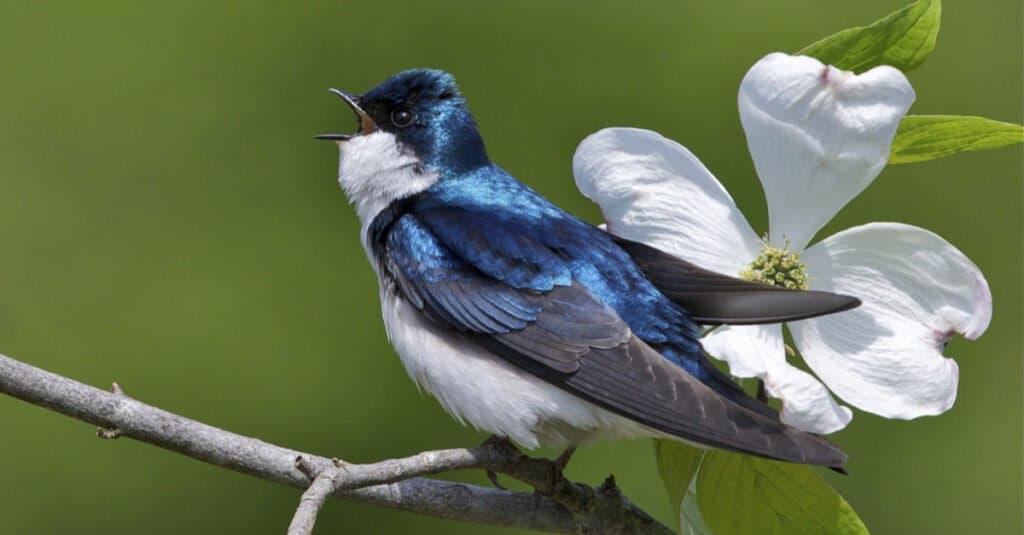
Tom Reichner/Shutterstock.com
These incredibly beautiful metallic-blue birds can be seen perched on fences or skimming over water surfaces snacking on insects. You can also find them in grassy fields, lakes, and marshes.
- Color: Males are a bright, iridescent blue-green with blackish wings and tail and white underparts. Females are a dull brown with little to no iridescence.
- Diet: Although they'll eat seeds and berries in general, their berry of choice is the bayberry. In Summer, they eat mostly insects like flies (about 40% of their diet), beetles, winged ants, and others. They will also make room for some spiders and sand fleas.
The tree swallow's dating life is quite interesting since part of their courtship is while the male is showing the female potential nesting sites. He arrives first and when she joins him, he shows her the area. (Only in the animal kingdom. You can't make this stuff up.)
They breed in cavities. You can also spot them in nest boxes designed for bluebirds since they both nest in holes of exactly the same size. (They've obviously gotten wind of Airbnb deals.)
The nest is built by the female and consists of grass, weeds, moss, pine needles, and other plant materials. It's often lined with the feathers of other birds. Both parents feed the nestlings and it's usually a yummy meal of insects.
Mobbing behavior is common when predators are present near the nest. The tree swallow will swarm and dive towards the intruder without actually touching them.
The intensity of the attacks changes depending on what type of predator is approaching.
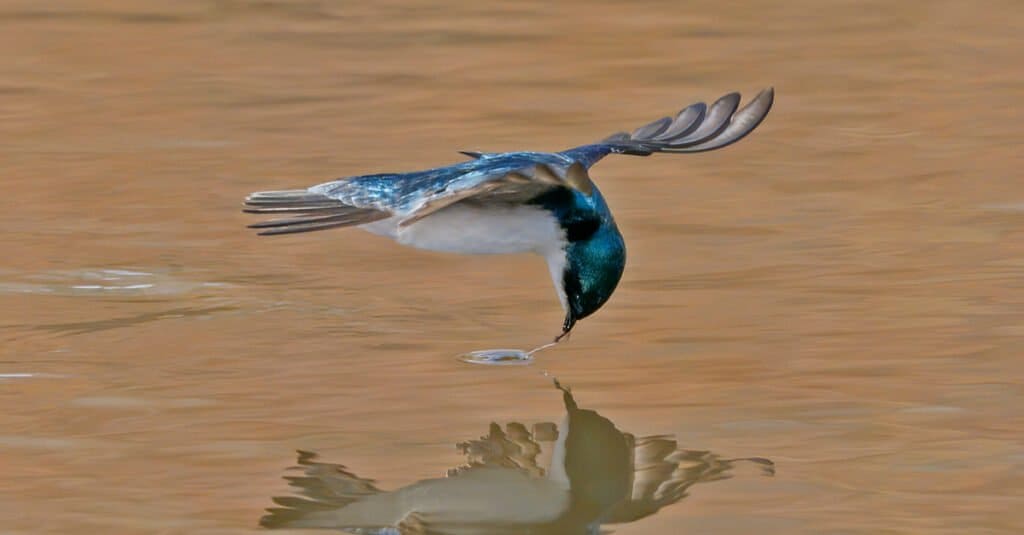
Richard Seeley/Shutterstock.com
Fun fact: (But it's pretty serious and important when you get right down to it.)
The tree swallow is sometimes considered to be a model organism due to the large amount of research done on it.
A model organism is a non-human species that is extensively studied to understand particular biological phenomena, with the expectation that discoveries made in the model organism will provide insight into the workings of other organisms.Model organisms are widely used to research human disease when human experimentation would be unfeasible or unethical.
All of the birds mentioned in this article are protected under the Federal Migratory Bird Treaty Act (MBTA) which was passed in 1918 to combat over-hunting and poaching that supplied the enormous demand for feathers to adorn women's hats. State-level hunting laws were not working, and bird populations were being decimated.
The Act makes it a federal crime to "take" birds or bird parts, including feathers, or to kill birds without special permission from the Secretary of the Interior.
Only "native" migratory bird species are protected under the MBTA, and there are now 1,026 species covered by the Act, including common birds such as the American crow and 74 rare birds also on the Endangered Species list.
More from A-Z Animals
Source: https://a-z-animals.com/blog/5-types-of-birds-that-are-blue/
0 Response to "Birds That Are a Sort of Blackinsh Blue"
Postar um comentário